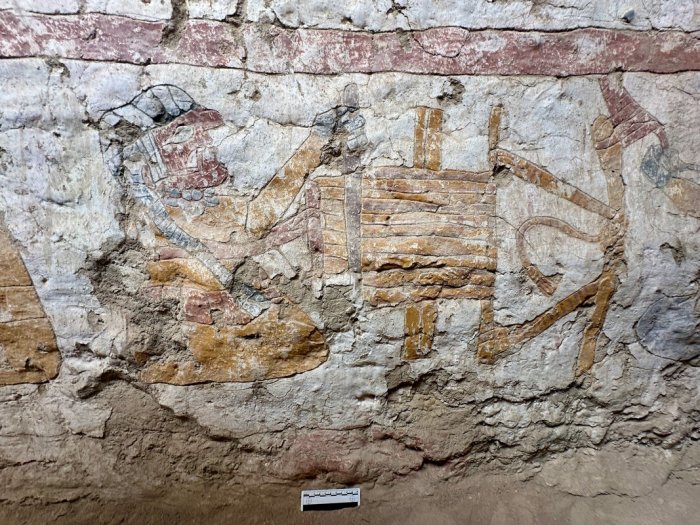
Archaeologists Uncover Exceptionally Decorated Throne Room at Ancient Peruvian Location

# Recent Archaeological Discovery in Peru: A Beautifully Painted Moche Throne Room Found at Pañamarca
In Peru, archaeologists have made a remarkable and historically valuable discovery that has left researchers both astonished and thrilled. Situated in the lower Nepeña Valley on a secluded granite hill, the once-prosperous ancient site of Pañamarca has revealed an exquisite throne room from the **Moche culture**, embellished with vivid wall paintings that have enchanted the archaeological field. This extraordinary find illuminates the Moche civilization, a complex pre-Columbian society that thrived along Peru’s northern coast.
While Moche findings typically consist of tombs, elaborate ceramics, and fascinating art, this particular discovery—the ornately painted throne room—highlights a prominent female figure, possibly a queen or priestess, unexpectedly challenging traditional historical narratives surrounding gender dynamics within the Moche society.
## The Moche Civilization: A Brief Overview
The **Moche civilization**, flourishing between 350 and 850 C.E., is recognized for its architectural wonders, including pyramids, temples, and opulent burial sites for their elite. Famed for their intricate art, the Moche produced exquisite ceramics, advanced irrigation systems, and murals depicting religious rituals and daily activities, providing insight into their social and political frameworks.
Conventional portrayals of the Moche focus on male warriors, priests, and deities, featuring elaborate depictions of ritual warfare and sacrifice. However, the discovery reported at Pañamarca is poised to disrupt some of these established narratives, particularly regarding women’s positions within this ancient culture.
## A Remarkable Find at Pañamarca: The Painted Throne Room
The recent discovery at Pañamarca, unveiled by the **Archaeological Landscapes of Pañamarca** initiative, is significant on multiple fronts. This project, a partnership between Peruvian and American archaeologists, was initiated in 2018 to investigate pre-Columbian activities in the region, and this latest find is likely to become one of their most notable achievements.
The adobe throne was excavated from an area referred to as the “**Hall of the Moche Imaginary**,” a chamber encircled by murals on both walls and pillars. These murals portray **four distinct scenes featuring a powerful female figure** associated with imagery linked to the crescent moon, aquatic life, and the crafts of spinning and weaving—potentially indicating her leadership within this setting. The vibrant murals appear to depict her seated on the throne, receiving guests in a manner that reinforces the notion of her substantial power, perhaps enhanced by divine or mythical connections.
One scene illustrates a group of women engaged in spinning and weaving textiles, vital skills within the Moche economy and commonly represented in their artwork. Male figures are shown in processions, carrying woven textiles and the female leader’s crown, adorned with intricately drawn braids—possibly symbolizing her authority.
“This discovery is unparalleled,” remarks **Lisa Trever**, a professor of art history at Columbia University and one of the lead researchers. “Not only do we witness the creative talent and imagination of Moche artists, but we are also uncovering fresh perspectives on the potential political and ceremonial functions of women.”
## Gender Dynamics in the Moche Society
One of the most thrilling aspects of this discovery is its capacity to question long-standing beliefs about gender roles in ancient Peru. While numerous previous archaeological investigations of the Moche have concentrated on elite male warriors and priests, the portrayal of women in authoritative roles within these murals sparks new discussions regarding female leadership in pre-Columbian cultures.
The central figure, a woman depicted seated on a throne, is seen conducting ceremonial processions and accepting gifts from male attendants. Such imagery may imply she held an authoritative position, potentially as a **queen, priestess, or even a goddess**. The connection to the crescent moon and weaving aligns with divine symbols often associated with women in Moche iconography.
Though the murals could represent metaphorical or mythical interpretations, physical evidence, including the damaged backrest of the adobe throne and the discovery of **greenstone beads, fine threads, and human hair**, indicates the existence of a tangible occupant—a **seventh-century female leader** whose legacy is reflected in these artistic representations.
## Preserving the Murals for Future Generations
While the enthusiasm surrounding this discovery is tremendous, **Jessica Ortiz Zevallos**, a project director for Archaeological Landscapes of Pañamarca, highlights the challenges associated with long-term conservation. As the murals are crafted from delicate adobe and adorned with natural pigments, they are susceptible to environmental deterioration. Zevallos warns that the wall paintings could swiftly erode if left exposed to the elements without an ongoing preservation effort.
For this reason, the site—and the newly uncovered throne room—remains closed to the public. Researchers are taking careful measures